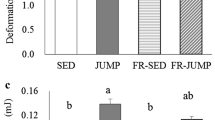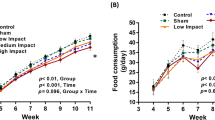Abstract
Jump exercise in rats creates high-impact loading on lower limbs and results in the promotion of osteogenesis. Although we clarifi ed that a few loadings per day could increase bone mass and strength within 8 weeks, we did not observe an osteogenic response at the onset of the training period. The purpose of this study was to clarify whether the bone formation rate measured by the double-label immunofluorescence method increases with a few loadings for a short period. Forty female Wistar rats, 10 weeks old, were divided into a control group and three exercise groups: the 10 jumps/day (10 J) group, 40 jumps/day (40 J) group, and 100 jumps/day (100 J) group. The exercise groups were trained on days 1, 3, and 5, the fluorescent labels were injected on days 5 and 12, and the experiment ended on day 16. The bone formation rates were greater in all exercise groups compared with the control group and were significantly greater in the 40 J and 100 J groups than in the 10 J group. These data show that only 10 repetitions/day loading promotes the osteogenic response within a short period from the onset of the training.
Similar content being viewed by others
References
Welch JM, Weaver CM, Turner CH (2004) Adaptations to free-fall impact are different in the shafts and bone ends of rat forelimbs. J Appl Physiol 97:1859–1865
Hou JC, Salem GJ, Zernicke RF, Barnard RJ (1990) Structural and mechanical adaptations of immature trabecular bone to strenuous exercise. J Appl Physiol 69:1309–1314
Jarvinen TL, Kannus P, Sievanen H, Jolma P, Heinonen A, Jarvinen M (1998) Randomized controlled study of effects of sudden impact loading on rat femur. J Bone Miner Res 13:1475–1482
Turner CH, Owan I, Takano Y (1995) Mechanotransduction in bone: role of strain rate. Am J Physiol 269:E438–E442
Duncan RL, Turner CH (1995) Mechanotransduction and the functional response of bone to mechanical strain. Calcif Tissue Int 57:344–358
Frost HM, Ferretti JL, Jee WS (1998) Perspectives: some roles of mechanical usage, muscle strength, and the mechanostat in skeletal physiology, disease, and research. Calcif Tissue Int 62:1–7
Forwood MR, Turner CH (1995) Skeletal adaptations to mechanical usage: results from tibial loading studies in rats. Bone (NY) 17:197S–205S
Lanyon LE, Rubin CT (1984) Static vs dynamic loads as an influence on bone remodelling. J Biomech 17:897–905
Mosley JR, March BM, Lynch J, Lanyon LE (1997) Strain magnitude related changes in whole bone architecture in growing rats. Bone (NY) 20:191–198
Rubin CT, Lanyon LE (1985) Regulation of bone mass by mechanical strain magnitude. Calcif Tissue Int 37:411–417
Mosley JR, Lanyon LE (1998) Strain rate as a controlling influence on adaptive modeling in response to dynamic loading of the ulna in growing male rats. Bone (NY) 23:313–318
Rubin CT, Lanyon LE (1984) Regulation of bone formation by applied dynamic loads. J Bone Joint Surg [Am] 66:397–402
Umemura Y, Ishiko T, Yamauchi T, Kurono M, Mashiko S (1997) Five jumps per day increase bone mass and breaking force in rats. J Bone Miner Res 12:1480–1485
Turner CH (1998) Three rules for bone adaptation to mechanical stimuli. Bone (NY) 23:399–407
Cullen DM, Smith RT, Akhter MP (2001) Bone-loading response varies with strain magnitude and cycle number. J Appl Physiol 91:1971–1976
Forwood MR, Owan I, Takano Y, Turner CH (1996) Increased bone formation in rat tibiae after a single short period of dynamic loading in vivo. Am J Physiol 270:E419–E423
Umemura Y, Ishiko T, Tsujimoto H, Miura H, Mokushi N, Suzuki H (1995) Effects of jump training on bone hypertrophy in young and old rats. Int J Sports Med 16:364–367
Honda A, Sogo N, Nagasawa S, Shimizu T, Umemura Y (2003) High-impact exercise strengthens bone in osteopenic ovariectomized rats with the same outcome as Sham rats. J Appl Physiol 95:1032–1037
Notomi T, Lee SJ, Okimoto N, Okazaki Y, Takamoto T, Nakamura T, Suzuki M (2000) Effects of resistance exercise training on mass, strength, and turnover of bone in growing rats. Eur J Appl Physiol 82:268–274
Notomi T, Okimoto N, Okazaki Y, Tanaka Y, Nakamura T, Suzuki M (2001) Effects of tower climbing exercise on bone mass, strength, and turnover in growing rats. J Bone Miner Res 16:166–174
Hart KJ, Shaw JM, Vajda E, Hegsted M, Miller SC (2001) Swim-trained rats have greater bone mass, density, strength, and dynamics. J Appl Physiol 91:1663–1668
Author information
Authors and Affiliations
Corresponding author
About this article
Cite this article
Nagasawa, S., Honda, A., Sogo, N. et al. Effects of low-repetition jump exercise on osteogenic response in rats. J Bone Miner Metab 26, 226–230 (2008). https://doi.org/10.1007/s00774-007-0812-6
Received:
Accepted:
Published:
Issue Date:
DOI: https://doi.org/10.1007/s00774-007-0812-6




